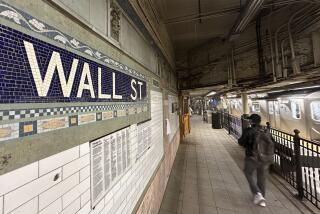Productivity Surprisingly Drops 0.6%
- Share via
WASHINGTON — U.S. business productivity fell unexpectedly in the fourth quarter and labor costs accelerated sharply in what could be an early sign of wage inflation, a government report indicated Thursday.
The Labor Department said nonfarm business productivity fell at a 0.6% annual rate in the fourth quarter, marking the first decline since the first quarter of 2001. That pushed unit labor costs up at a 3.5% pace -- the fastest growth in a year and well above market expectations.
“With energy costs sky-high and compensation increasing, it is going to be very tough to keep inflation from accelerating this year,” said Joel Naroff, chief economist at Naroff Economic Advisors. “So if you were wondering why the Fed keeps raising rates, wonder no more.”
Wall Street had expected a fourth-quarter slowdown in productivity growth to a 1.6% rate, and the outright decline raised fears of more interest-rate hikes.
Strong productivity growth in recent years had allowed employers to keep costs low even as output increased. An end to that growth suggests that businesses have squeezed as much efficiency out of their workforce as possible, and are having to hire new employees and boost spending to keep up.
But some analysts said the drop in productivity was partly because of distortions from the hurricanes that smashed into the U.S. Gulf Coast in late summer, cutting production.
“This could be a temporary blip,” said Patrick Fearon, senior economist at A.G. Edwards & Sons in St. Louis.
Third-quarter productivity growth also was revised lower, to a 4.5% clip from the previously reported 4.7% increase.
For 2005, growth in business productivity rose at a 2.7% annual rate, down from 3.4% growth in 2004 and the slowest increase since 2001.
Unit labor costs were up 2.4% in 2005, more than double 2004’s 1.1% gain and the largest annual increase since a 4.2% gain in 2000.
Economists had expected only a 2.3% increase in fourth-quarter unit labor costs -- a key gauge of profit and price pressures -- and the sharp acceleration in employer costs suggests inflation pressures may be hitting the labor market.
“Unit labor costs were up 3.5% which, if sustained, would suggest increased labor cost pressures down the road,” said Cary Leahey, senior managing director at Decision Economics in New York.
“But ... the trend in unit labor costs is still declining, and I would argue that the market and the Fed will say that this is a one-time surge,” Leahey said.
The Federal Reserve has raised interest rates 14 times since June 2004 in a bid to stave off inflation pressures.
A second report from the Labor Department suggested the job market had tightened further since the fourth quarter.
New claims for U.S. unemployment benefits fell unexpectedly to 273,000 last week from 284,000 the previous week, pushing a four-week average of claims to the lowest level in nearly six years. Wall Street had expected claims to rise to 295,000.
More to Read
Inside the business of entertainment
The Wide Shot brings you news, analysis and insights on everything from streaming wars to production — and what it all means for the future.
You may occasionally receive promotional content from the Los Angeles Times.










